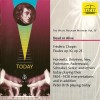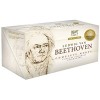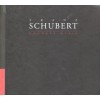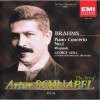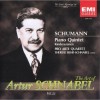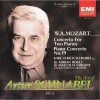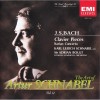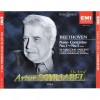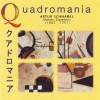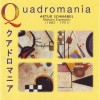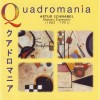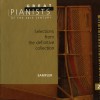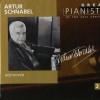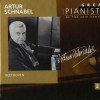| Voice/Instrument: | Pianoforte |
Biography
Born: April 17, 1882 - Lipnik, Poland
Died: August 15, 1951 - Axenstein, Switzerland
The celerbrated Austrian-born American pianist and pedagogue, Artur Schnabel, studied piano from the age of seven in Vienna under Theodor Leschetizky who said to him "You will never be a pianist. You are a musician." Schnabel took these words to heart, and rather than playing the showy virtuoso pieces by composers like Franz Liszt which were popular in the late 19th century, he chose to concentrate on Germanic classics by Mozart, Beethoven and Schubert. Later, Schnabel also studied composition under Eusebius Mandyczewski who was a friend of Johannes Brahms.
In 1900, Artur Schnabel moved to Berlin where he began his career as a professional pianist. He gained some fame thanks to orchestral concerts he gave under the conductor Artur Nikisch as well as playing in chamber music and accompanying his future wife, the contralto Therese Behr, in lieder. It seems that Behr had some influence over Schnabel's repertoire, encouraging him to explore the sonatas of Schubert and the works of Brahms. Following World War I, he toured widely, visiting the USA, Russia and England. From 1925 he taught at the Berlin State Academy where his master-classes brought him great renown.
Artur Schnabel was known for championing the then-neglected sonatas of Schubert and, even more so, Beethoven. At that time, Beethoven's piano music was little played and largely unappreciated by the public. While on a tour of Spain, he wrote to his wife saying that during a performance of Beethoven's Diabelli Variations he had begun to feel sorry for the audience. "I am the only person here who is enjoying this, and I get the money; they pay and have to suffer," he wrote. Schnabel did much to popularize Beethoven's music, giving the first complete cycle of his piano sonatas (that is, he played every piano sonata by Beethoven in a series of concerts) and also making the first recording of them all, completing the set in 1935. This set of recordings has never been out of print, and is considered by many to be the touchstone of Beethoven sonata interpretations, though occasional shortcomings in finger technique mar his performances of fast movements (Sergei Rachmaninov is supposed to have referred to him as "the great adagio pianist"). He also recorded all the Beethoven piano concertos. Despite his playing repertoire almost never leaving the works of Beethoven, Schubert, Mozart and Brahms, almost all of his compositions (none of which are in the active repertoire) are atonal.
Artur Schnabel played with a number of famous musicians in chamber works, including the violinists Carl Flesch and Joseph Szigeti, the violist Paul Hindemith, and the cellists Pablo Casals and Pierre Fournier. Among his piano pupils were Leon Fleisher, Alan Bush, Nancy Weir, Eunice Norton and radio personality Karl Haas.
Artur Schnabel, a Jew, left Berlin in 1933 after the Nazi Party took control. He lived in England for a time while giving masterclasses at Tremezzo on Lake Como in Italy, before moving to America in 1939. In 1944, he became a naturalized citizen of the USA. There he took a teaching post at the University of Michigan, returning to Europe at the end of World War II. He continued to give concerts on both sides of the Atlantic until the end of his life; his list of compositions eventually included symphonies, a piano concerto and five string quartets amongst various smaller works. And he continued to make records, though he was never very fond of the whole studio process.
Artur Schnabel's book My Life and Music, is a mixture of autobiography and commentary on a variety of musical subjects.

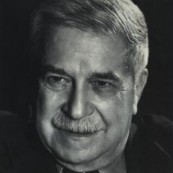
![The Welte-Mignon Mystery Vol.07 [0146-0] - Artur Schnabel](http://static.classicalm.com/repository/disk-cover/small/12999-img1664626010553085.jpg)

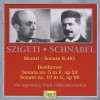
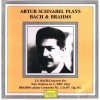
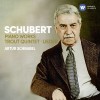
![Beethoven: Complete Works [Brilliant Classics 100 CD Box] - CD 086-100 - Historical Recordings](http://static.classicalm.com/repository/composition-cover/small/43310-img1648135445673309.jpg)


![Beethoven - Complete Sonatas - Artur Schnabel [Pristine]](http://static.classicalm.com/repository/composition-cover/small/32911-img1536056349392756.jpg)
